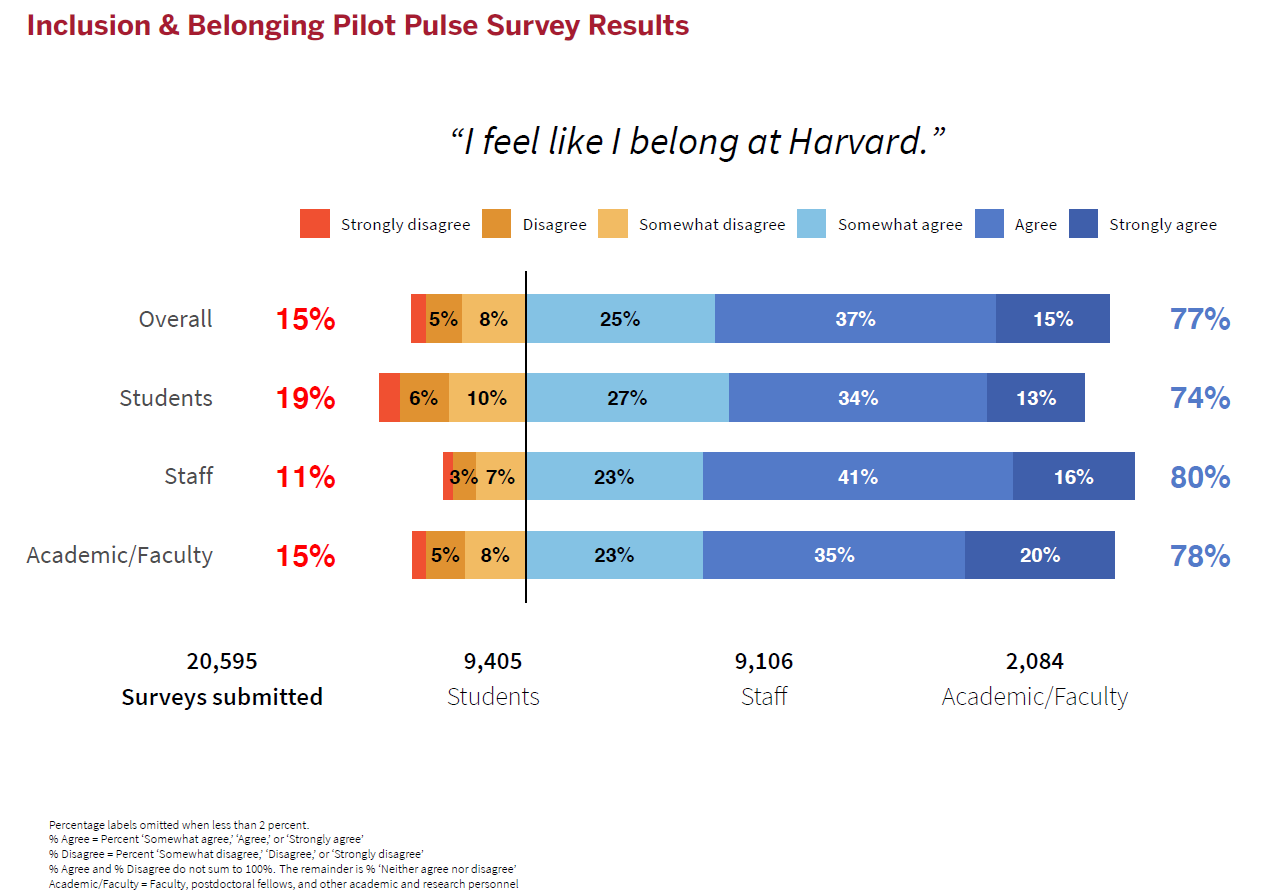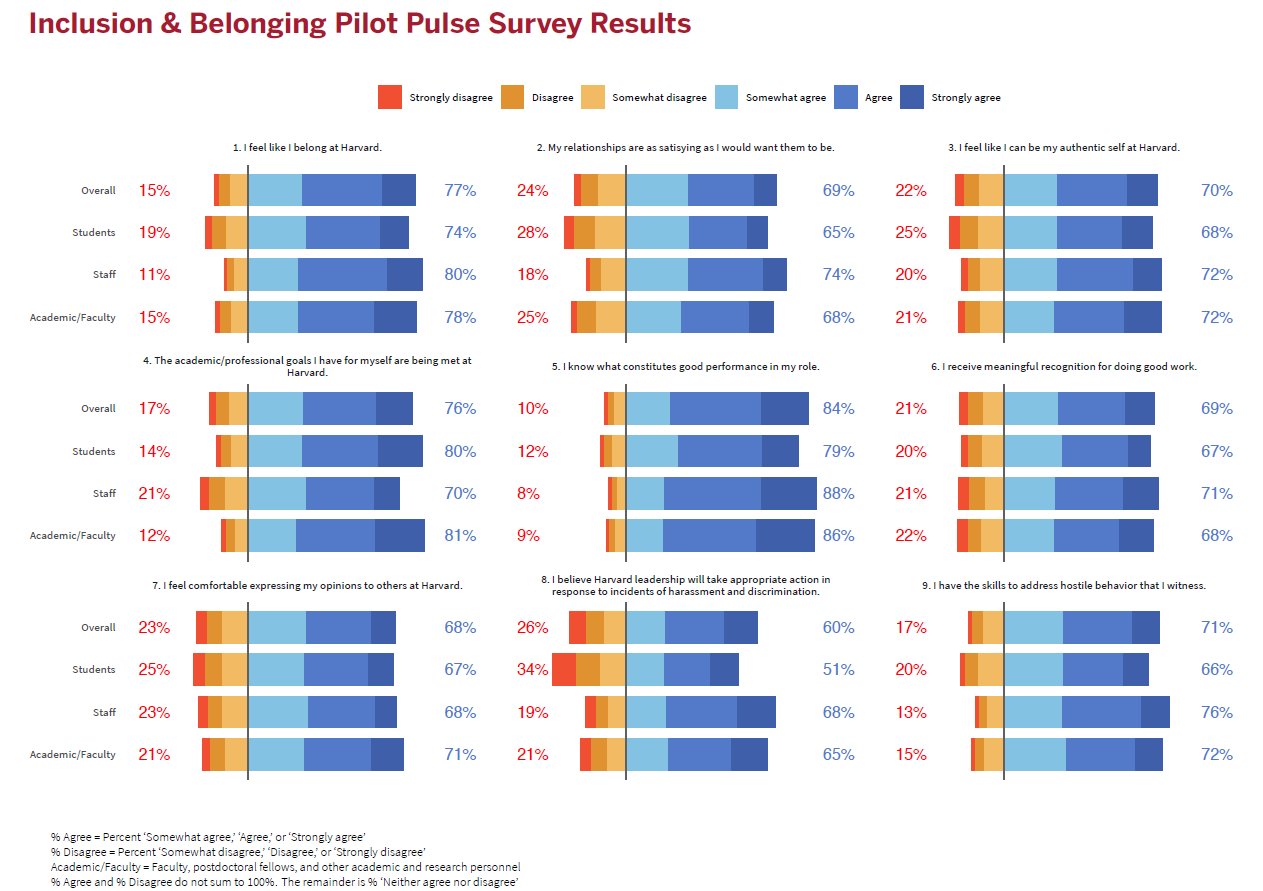Executive Summary
Click here to download the Executive Summary
In the spring of 2019, for the first time in its history, Harvard asked everyone in its community to share perceptions about inclusion and belonging at Harvard in order to count the individual experiences of every single Harvard community member. Responses to the survey are intended to help inform priorities, practices, and policies in the months and years to come. Although no survey can illuminate all there is to remedy, nor prescribe all that could be done, this 3-minute “pulse survey” is an important first step toward understanding more about inclusion and belonging. Overall, seven in ten people feel like they belong at Harvard, but three in ten do not. We must, as a University and a community, identify what actions we will take to help lift those three in ten that report the lowest levels of belonging. While there are some actions that the University can pursue in terms of policies and procedures to improve the culture for those that report the lowest levels of belonging, this survey highlights that we have a shared responsibility to celebrate the bright spots, confront the challenges, and inspire additional efforts to understand how and where we can all improve in order to achieve our goal of sustainable and inclusive excellence at Harvard.
Key Findings
-
With 20,595 respondents, the Pilot Pulse Survey on Inclusion and Belonging is the largest optional survey in Harvard’s history. 44% of the Harvard community participated, including 9,405 students (39%), 9,106 staff (52%), and 2,084 (37%) academic personnel and faculty.
-
77% of respondents agreed with the statement, “I feel like I belong at Harvard,” including 15% who “strongly agree,” 37% who “agree,” and 25% who “somewhat agree.” 15% of respondents disagreed, including 2% who “strongly disagree,” 5% who “disagree,” and 8% who “somewhat disagree.” The remaining 8% selected “neither agree nor disagree.”
-
Among self-reported demographic subgroups, respondent categories with less than 70% reported belonging include, Genderqueer and Nonbinary respondents (53%), Muslim respondents (66%), Middle Eastern respondents (68%), Black or African American respondents (69%), and Bisexual respondents (69%).[1]
-
Belonging at Harvard was similar across roles. Agreement with the statement, “I feel like I belong at Harvard,” was highest among staff (80% strongly agree, agree, or somewhat agree), followed by academic personnel and faculty (78%), and students (74%).
-
Disagreement with questions on the survey differed by role. Among students, the question with the most disagreement was: “I believe Harvard leadership will take appropriate action in response to incidents of harassment and discrimination.” 34% of students disagreed, more than any other question for students. Among staff, the question with the most disagreement was: “I feel comfortable expressing my opinions to others at Harvard.” 23% of staff disagreed, more than any other question for staff. Among academic personnel and faculty, the question with the most disagreement was: “My relationships at Harvard are as satisfying as I would want them to be.” 25% of academic personnel and faculty disagreed with this statement, more than any other question for academic personnel and faculty.
-
Across all roles, items, and subgroups, the lowest agreement was for the statement: I believe Harvard leadership will take appropriate action in response to incidents of harassment and discrimination. The lowest agreement was among Genderqueer and Nonbinary students (19% agreed), Genderqueer and Nonbinary staff (34%), Black or African American students (37%), and Bisexual students (26%)
-
The last prompt on the survey solicited specific suggestions for improving the climate for all members of the Harvard community. Over 1/3 of respondents provided a total of 7,273 open-ended comments and specific suggestions.
[1] To ensure confidential and precise results, some demographic categories with small sample sizes were aggregated. Aggregated categories with agreement below 70% on Question 1 include gender: “transgender,” “unsure,” or “another gender identity” (57%); sexual orientation: “another sexual orientation,” or “unsure” (63%); political ideology: “another political ideology,” or “I prefer not to say” (63%); and race/ethnicity: “American Indian or Alaska Native,” “Native Hawaiian or other Pacific Islander,” or “another race/ethnicity” (68%).
Response
The results show that respondents, across all three roles, report rates of inclusion and belonging in the positive range across most categories. However, that picture changes markedly when one looks more closely at specific demographic groups within the Harvard community. While most responded positively across all items, those from historically underrepresented and disadvantaged groups reported less positive views and higher levels of disagreement with the prompts.
The Office for Diversity, Inclusion, and Belonging (ODIB) has identified a series of immediate next steps/actions; with some already underway. ODIB believes that it will be important to take the necessary time and care to formulate a detailed action plan in response to these survey results. For many of the problems that surfaced in the survey, the solutions will be complex, multilayered, and interdependent. However, the University community is committed to action, and given some of the results documented in this report, we all should have an urgency to act. We must also recognize the shared responsibility of this work. ODIB believes that this survey should serve as a call to action so we can each identify ways to create a fully inclusive community culture.
The meaningful data presented here will be vital in developing and implementing concrete steps and actions in order to ensure that we bring all those that reported a lower sense of belonging up to the level of the majority. Specifically:
-
The robust University-wide response suggests “pulse” strategies can be an effective method to understand high-level feelings of inclusion and belonging at Harvard. An important next step will be the administration of the first official I&B Pulse survey in 2021, with surveys to follow every two years. Consistent with this pilot, the surveys will report results at the University-level.
-
The formation of the Diversity, Inclusion & Belonging (DIB) Leadership Council made up of School DIB leads and those in central administration working to advance DIB across the University. The goal of this monthly convening will be to generate actions in response to the survey, better coordinate efforts, and share promising practices for local implementation.
-
The hiring of a University Chief Diversity and Inclusion Officer. ODIB has engaged an executive search firm to identify a candidate for this position that will:
-
Provide direction on a broad range of services, programs, policies, and procedures for staff, students, administrators, and faculty.
-
Identify and implement evidence-based strategies in response to the survey findings.
-
Serve as a central resource to matrix staff, organizational leaders, and stakeholders to identify and help develop constituency‐specific responses.
-
-
Regular meetings of DIB practitioners across the University to share best practices and surface challenges.
-
The creation of a new University-wide website (dib.harvard.edu) to serve as a central resource and learning hub for diversity, inclusion, and belonging related programs and initiatives across the University.
-
Utilize I&B Pulse survey findings to inform development of University-wide strategic planning for diversity, inclusion, and belonging.
-
Continued School/Unit strategic planning in diversity, inclusion, and belonging, grounded in and incorporating the results of this survey. Future plans will identify the specific efforts implemented to address the concerns of the groups that reported a lesser sense of inclusion and belonging through this survey
-
The 7,273 open text comments included important views and suggestions on how to advance inclusion and belonging at Harvard. These comments will be shared with senior leadership and factored into University and School/Unit strategic planning in diversity, inclusion, and belonging. Some high-level trends and consistent themes across the comments included:
-
Differing viewpoints: Specifically, the need for receptiveness of non-majority or traditionally non-accepted views, and additional efforts to address the lack of empathy around differing viewpoints.
-
Career: The need for clarity around career paths/professional development and additional/more consistent training for managers.
-
Harvard experience: Submitted comments reflected that individual experiences at Harvard are often siloed. They noted that it is difficult to understand and learn how to navigate the University outside of one’s immediate surroundings at Harvard. Comments highlighted an opportunity to establish One-Harvard programs, tools, resources, spaces, and integration.
-
Submitted comments included references to some high-profile matters being discussed on campus during the administration of the survey in the spring of 2019, including:
-
Divestment
-
Need for student-controlled space, multicultural center
-
Student unionization
-
-
-
This pilot yielded some significant learnings as we prepare for the administration of the next survey, specifically on the demographic questionnaire: adding a question on disability status, refining parents’ education question, as well as better describing the range of gender identities and sexual orientation. We will further refine this demographic questionnaire and encourage its use as a diversity, inclusion, and belonging best practice and model for collecting demographic data on surveys across campus.
ODIB will continue to welcome feedback on the survey instrument, the demographic questionnaire, and the proposed adjustments for future I&B Pulse surveys that are described in the full report.


